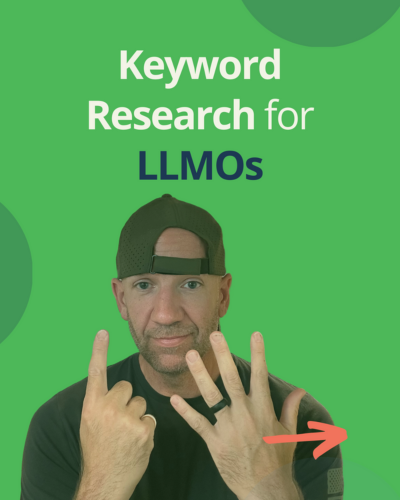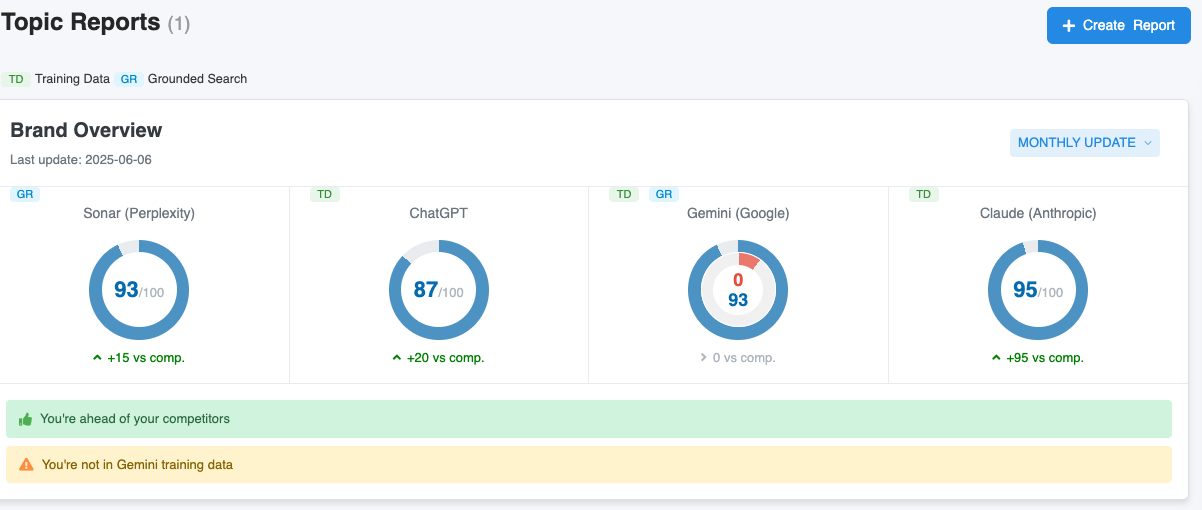LLMO vs SEO: How to Optimize for AI-Generated Search Results
LLMO is here—and traditional SEO isn't the only game in town anymore. The rise of AI tools like ChatGPT, Perplexity, Claude, and Google AI Overview is changing how people find and consume content. This shift calls for a new approach: LLMO, or Large Language Model Optimization.
But what exactly is LLMO? And how does it stack up against traditional SEO, especially for B2B marketers? In this post, we’ll break down LLMO vs SEO, explore how large language models pull their answers, and share practical tips to make your content visible across AI-powered platforms—whether you're targeting search engines or AI assistants.
Also Read:
LLMO Resources:
5 Key Takeaways from this post:
LLMO is the next evolution of SEO — focused on getting your content cited by AI tools like ChatGPT and Perplexity.
Structure matters — learn how to format content so AI can find and reuse it.
Ranking vs. Reuse — LLMO targets content fragments that AI can quote, not just full pages.
Use the right formats — how-to guides, FAQs, and comparisons perform best in AI results.
Track your visibility — with tools like GA4, Perplexity source view, and AI-specific platforms.
TL;DR:
LLMO (Large Language Model Optimization) is the next evolution of SEO—focused on getting your content cited by AI tools like ChatGPT, Perplexity, Claude, and Google AI Overviews.
Unlike traditional SEO, which targets search rankings, LLMO optimizes your content so AI can understand, extract, and reference it in conversational answers.
To succeed, structure content clearly, use fact-rich summaries, build topic clusters, and monitor AI visibility through tools like SE Ranking, Keyword.com, and manual testing.
Bottom line: SEO helps you rank—LLMO helps you get quoted. You need both.
Table of Contents Show
What Is LLMO?
LLMO (Large Language Model Optimization) changes the game when it comes to content visibility - especially in B2B SEO. While traditional SEO focuses on search engine rankings, LLMO is about making your content easy for AI systems like ChatGPT, Claude, Perplexity, and Gemini to find and actually use.
The main goal? Getting your content referenced, quoted, or cited when AI systems create responses. When someone asks Perplexity about marketing strategies or asks ChatGPT for business advice, you want your expertise showing up in those answers. This creates a completely new type of organic visibility that skips traditional search results entirely.
LLMO means structuring content so machines can understand it, not just humans scanning it. This changes our focus from keyword density to semantic clarity, from isolated topics to clear connections between ideas, and from basic formatting to information that's easy to extract. You need content that maintains authority, factual accuracy, and logical organization that AI systems can actually parse and use.
Here's something interesting: research shows that large language models are significantly more likely to reference content that includes unique statistics, original research, or proprietary datasets. This evidence-based approach builds credibility and makes it more likely your content gets cited in AI responses.
The New Way to Search
Search has moved from simple keyword queries to natural, conversational questions. People increasingly skip traditional search engines entirely, heading straight to AI assistants for answers, recommendations, and explanations. The numbers tell the story: 61.7% of global AI search engine market activity is attributed to web search in 2025, showing how users have moved many of their daily information tasks to AI-enhanced services.
Traditional search dominance faces real challenges. Google's market share decline happens alongside ChatGPT maintaining its position as the most widely used generative AI chatbot in the U.S. and Perplexity emerging as one of the fastest-growing AI-powered search tools. This fragmentation shows users are getting comfortable with AI-powered information retrieval across multiple platforms.
Google is responding with its own AI features, but the competitive landscape keeps changing rapidly. This transformation represents the biggest shift in information discovery since Google's original algorithm first appeared, completely changing how brands need to think about digital visibility.
Why Marketers Need to Adapt
The impact on traditional organic traffic is substantial and happening right now. Organic CTR dropped by more than half for informational queries where AI Overviews appeared, falling from 1.41% to 0.64% year over year. This dramatic drop shows how AI-generated answers reduce the need for users to click through to individual websites.
Zero-click searches represent a fundamental challenge to traditional content marketing. AI Overview prevalence increased significantly, appearing in 42.51% of search results in Q4 2024, up 8.83 percentage points from the previous quarter. Users increasingly get complete answers without visiting the original source.
But here's the opportunity within this challenge: Both paid and organic CTRs increased when a brand appeared within AI Overviews, with paid CTR jumping from 7.89% to 11% and organic CTR rising from 0.74% to 1.02%. This data suggests that securing AI mentions can actually boost your overall visibility rather than simply replacing traditional traffic sources.
LLMO goes beyond traditional keyword-based SEO by leveraging content analysis and pattern recognition, boosting visibility by up to 45% compared to keyword-only strategies. This comprehensive approach addresses content gaps and unmet user needs across various AI platforms, creating multiple ways to reach your audience.
LLMO vs SEO: Key Differences
| Feature | Traditional SEO | LLMO (Large Language Model Optimization) |
|---|---|---|
| Goal | Rank on Google SERPs | Get cited by AI tools like ChatGPT & Perplexity |
| Keyword Use | Exact-match keywords | Semantic clarity and contextual relevance |
| Content Structure | H1s, Meta, Internal Links | Headings, summaries, semantic HTML, TL;DRs |
**SEO and LLMO share a foundation—** both rely on E-E-A-T, topical authority, and clear structure. But the key difference is how and why that structure is used.
Traditional SEO focuses on page-level ranking, where keyword strategy and backlinks play a central role. LLMO shifts the focus to fragment-level clarity: individual paragraphs, bullet points, and answers that can be extracted, reused, and cited by AI tools.
Instead of just optimizing for visibility in search engine result pages (SERPs), LLMO targets semantic relationships—how ideas connect, how clearly entities (like tools, people, and methods) are described, and how well the content can stand on its own as a referenced snippet.
To succeed with LLMO, content should:
Establish topic hierarchies (clear relationships between ideas)
Prioritize semantic structure over keyword stuffing
Use entity optimization to help AI systems recognize and trust your content
In short: SEO helps people find your page. LLMO helps AI use your content in the answers it delivers.
How LLMs Like ChatGPT & Perplexity Pull Answers
LLMs like ChatGPT, Perplexity, and Claude don't just rank pages—they extract and reuse fragments of content to answer questions. To get cited, your content needs to be trustworthy, well-structured, and easy to quote.
Source Authority
LLMs favor reputable domains with strong E-E-A-T signals. Author bios, quality citations, and content freshness all help reinforce credibility.
Structured Content
Clean formatting improves extractability. Use semantic HTML, clear H2/H3 headings, TL;DR-style summaries, and structured data to help AI understand your content layout.
Semantic Relevance
Rather than relying on exact-match keywords, LLMs prioritize semantic SEO. They look for logical topic relationships, contextual depth, and internal links that signal topical authority.
Entity Optimization
Clearly name and define people, brands, tools, and concepts. AI tools use entity recognition to determine what your content is about—and whether it's useful for answering specific prompts.
Citation-Friendliness
Content that's easy to quote gets surfaced more often. Keep sections concise, fact-rich, and well-attributed. Include bylines, dates, and avoid long intros or vague copy. Tools like ChatGPT with browsing and Perplexity can help you test if your content is being cited.
Bottom line: To show up in LLM responses, your content needs to be clear, authoritative, and structured like something worth quoting—not just ranking.
Content Formats That Work Best for LLM Optimization
LLMs like ChatGPT and Perplexity favor content that's structured, clear, and context-rich. These formats are proven to perform best when it comes to being cited or summarized by AI tools:
How-to Guides
Step-by-step instructions are ideal because they follow a logical structure and directly address user intent. LLMs can easily lift individual steps or summarize the entire guide. Use numbered lists, TL;DR summaries, and clear subheadings to increase extractability.
Comparisons
Side-by-side content like "LLMO vs SEO" or "ChatGPT vs Claude" naturally organizes differences and similarities. These formats are scannable, quotable, and often structured with tables or bullet points, which LLMs favor.
FAQs
Direct answers to common questions are exactly what AI tools are trained to surface. FAQs are compact, relevant, and typically written in an answer-ready format. Adding FAQ schema can further boost visibility.
Concept Explainers
Definitions and context around key ideas (e.g., "What is LLMO?") are frequently used by AI models to open or support responses. Starting with a one-sentence summary followed by supporting context improves your chances of being quoted.
Contextual Listicles
LLMs prefer lists that provide value beyond enumeration. "10 tools to track AI visibility (and how they work)" offers structured information with bite-sized explanations—ideal for AI extraction. Add context under each item for maximum impact.
Bottom line: The best formats for LLMO are structured, specific, and easy to cite. If your content looks like something an AI would want to quote, you're already ahead.
“These 10 tips are the foundation of LLMO—because it’s not just about ranking anymore. If you want your content to be found, cited, and reused by AI tools like ChatGPT or Perplexity, you have to structure it with clarity, authority, and purpose.””
10 Best Practices for LLMO (Large Language Model Optimization)
Here’s how to optimize for LLMs like ChatGPT, Claude, and Perplexity:
Use clear, declarative headings so AI tools can easily understand the structure and intent of each section.
Format answers up front using TL;DR summaries or concise intros that provide immediate value.
Provide fact-rich, citation-friendly content that AI can quote confidently and in context.
Add internal links to related content to improve semantic depth and signal topical authority.
Build topical authority by creating content clusters instead of one-off articles.
Use schema & structured data where appropriate to help AI systems parse your content accurately.
Add FAQ sections to all key pages to answer common questions in a format LLMs love.
Include author bios & expertise signals to reinforce credibility and trustworthiness.
Keep content fresh with regular updates so LLMs treat it as current and relevant.
Offer unique POVs or expert quotes to make your content more quotable and distinct from generic summaries.
This is the foundation of SEO for LLMs—structuring your content so it becomes a trusted, reusable source across AI platforms.
Tracking Your LLMO Performance
There's no perfect tool yet, but here are a few ways to monitor your progress.
Measuring how your content performs in AI-generated search is still evolving. While direct analytics remain limited, a mix of professional tools and manual methods can give you valuable insights into how LLMs like ChatGPT, Perplexity, and Gemini are using your content.
Google Analytics Referral Traffic Tracking for LLMs
Start with Referral Traffic in Google Analytics 4
Use GA4 to monitor spikes in referral traffic from unexpected sources. While ChatGPT, Perplexity, and other AI tools don’t always pass clear referrer data, unusual upticks or mentions from tools like Perplexity.ai may show up under referrals or unassigned traffic. Set up event tracking or UTM parameters on shareable links to help isolate AI-driven visits.
AI Results Tracker from SE Ranking
Professional Tools for AI Tracking
SE Ranking – AI Overviews Tracker Track whether your content appears in Google’s AI Overviews. Monitor inclusion across specific keywords, check ranking fluctuations, and view how your competitors are positioned in generative AI results.
Keyword.com Monitors citations in ChatGPT, Gemini, Perplexity, DeepSeek, and Mistral. Provides keyword-level insights, sentiment analysis, and competitive intelligence to understand where and how your brand appears in AI results.
Waikay,io
Waikay.io Specializes in AI brand visibility with tools for multi-model analysis, AI brand scoring, fact-checking, international support, and competitive benchmarking. Ideal for brands needing detailed, global LLM insights. - NOTE: We’re still testing this platform.
ChatGPT Prompt Testing
Manual Monitoring Methods
Perplexity Source Attribution Check the "Sources" feature on Perplexity to see if your content is being cited. Track citations weekly across key topic areas and note patterns over time.
Google AI Overviews Search your key topics and monitor if your content appears in Google's AI-generated summaries. Inclusion signals relevance; disappearing content may indicate freshness or formatting issues.
ChatGPT Prompt Testing Use ChatGPT with browsing to run targeted prompts around your content themes. Track how often your site or messaging shows up and which phrasing yields the most consistent citations.
Advanced Evaluation Techniques
Prompt-Based QA Incorporate AI-style questioning into your content review workflow. Use prompts to test how models interpret your key sections, definitions, and summaries. This surfaces issues with clarity or structure before publishing.
Semantic & Structural Testing Create a standardized set of prompts that evaluate content on factual accuracy, semantic relationships, and entity clarity. Identify and address weak spots that may block citation by LLMs.
Combine Multiple Indicators No single method is perfect, so triangulate your performance using a combination of:
AI citation visibility (via tools or manual checks)
Brand and keyword tracking
AI prompt testing
Referral traffic and engagement trends
👉 This Is New Territory—Expect Rapid Changes in Tracking Capabilities
Tracking AI-generated visibility is still in its early days. Most existing tools and methods are evolving alongside how LLMs pull and present information. As new tracking technologies emerge, expect better accuracy and more comprehensive data over time. For now, using a mix of available tools, manual testing, and referral traffic analysis gives you the best possible window into your AI visibility—and helps you stay ahead as the space matures.
SEO that Delivers...
Qualified Leads in just 3 months!
See how Matt from Tekkis and other SpearPoint clients are getting real qualified leads from SEO!
Final Thoughts: Future-Proofing Your Content with LLMO
Search behavior is changing—and LLMs are becoming the new homepage.
But this doesn't mean SEO is dead. LLMO isn't a replacement for SEO—it's the evolution of it.
At SpearPoint Marketing, we blend conversion-first SEO with LLM optimization to ensure your brand is found by humans and AI. Whether you're aiming to rank on Google or be cited in ChatGPT, we help you cover both.
✅ Top 10 Checklist for Staying Ahead in AI-Led Search
| Task | Description |
|---|---|
| ⬜ Add summaries to every post | Start with a TL;DR or direct answer to improve AI citation potential. |
| ⬜ Structure H2s/H3s clearly | Use descriptive subheadings so LLMs can easily segment your content. |
| ⬜ Answer common questions directly | Write concise, factual answers that AI tools can extract and reuse. |
| ⬜ Build internal links around key topics | Strengthen semantic relationships and signal topical authority. |
| ⬜ Add FAQ sections to core pages | Include direct Q&A formats that LLMs can easily parse and cite. |
| ⬜ Monitor citations in Perplexity | Check if and how your content is being used in AI-generated answers. |
| ⬜ Test with ChatGPT prompts | Run relevant prompts to see if your content appears or is paraphrased. |
| ⬜ Keep evergreen content updated | Refresh key pages regularly to maintain relevance in AI responses. |
| ⬜ Add expert quotes or unique insights | Make your content more quotable and distinct from generic sources. |
| ⬜ Include author bios with credentials | Boost trust and authority signals that LLMs factor into citation decisions. |
FAQs: LLMO Explained
Does LLMO replace traditional SEO entirely? LLMO complements rather than replaces traditional SEO. Both approaches work together to maximize digital visibility across search engines and AI platforms. Successful strategies integrate both methodologies rather than choosing one over the other, recognizing that different user intents favor different information discovery methods.
How long does it take to see LLMO results? LLMO results develop over longer timeframes compared to traditional SEO changes. AI models update periodically and incorporate new data gradually, meaning citation patterns develop as models retrain and update their knowledge bases. Expect to see initial results within 3-6 months of consistent optimization efforts.
Can I rely entirely on AI-generated content for LLMO? Over-reliance on AI-generated content reduces originality and trust, potentially harming both LLMO and SEO performance. Maintaining human expertise, editorial oversight, and unique perspectives remains crucial for building the authority that AI systems recognize and cite consistently.
Will traditional search become obsolete? Traditional search engines continue serving important functions alongside AI assistants. Different user intents and contexts favor different information discovery methods. A comprehensive digital strategy addresses both traditional search and AI-powered discovery channels rather than assuming complete replacement.
How do I measure LLMO success without perfect tracking tools? Success measurement requires combining multiple indicators including specialized AI monitoring tools, manual citation checking, brand mention tracking, referral traffic analysis, and systematic testing across AI platforms. While individual tools may be imperfect, combined metrics provide actionable insights into AI visibility performance.
The future of digital marketing lies in recognizing that users access information through multiple channels and optimizing for comprehensive visibility rather than single-platform dominance. LLMO represents a fundamental shift toward user-centric, multi-platform content strategies that deliver value regardless of how users discover information.
About the Author
By Jesse McFarland
SEO guy since 2007, Jesse is the founder of SpearPoint Marketing and a long-time digital strategist who helps brands grow through high-impact, conversion-focused SEO. With over 17 years of experience, he specializes in blending traditional SEO with modern strategies like LLMO to drive visibility across Google, ChatGPT, Perplexity, and beyond.
About Jesse
LinkedIn















